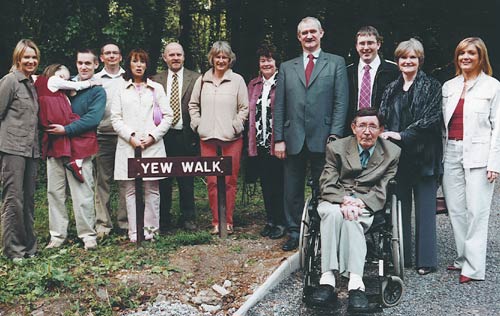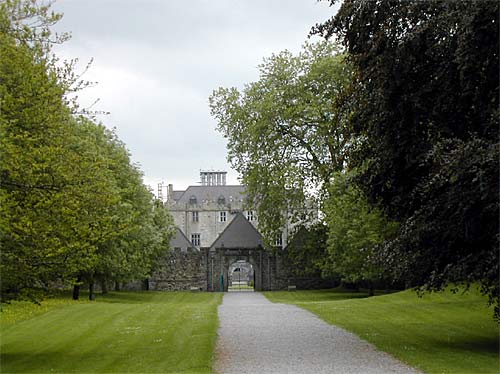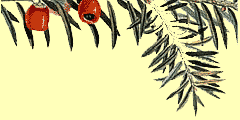Restored Yew Walk Opened in Portumna Forest Park
Portumna's restored Yew Walk was officially opened on the May [2004] Bank Holiday Monday by Councillor Jimmy McClearn in an event that was attended by a large crowd in brilliant sunshine.
The Yew walk is located between the Church of Ireland, Shannon Oaks Hotel and the Castle and was historically the link from the town to the Castle. The restoration plan was a long time vision of Sean Ryan formerly Coillte Forest Manager, who worked so hard with Tidy Towns and other Community groups to develop Portumna Forest Park. During the opening ceremony many speakers spoke eloquently of Sean and his family, and the dedication that he put into every project he took on board.
The restoration work involved many stakeholders, and included the resurfacing of the walkway and provision of lighting, which was carried out by Galway County Council. Coillte trimmed the Yew trees, erected signage and tidied up the forest along the walkway. National Monuments Service improved access from the Yew Walk to the Castle. Portumna Tidy Towns and Shannon Oaks Hotel also contributed to the project. Councillor McClearn erected the lights along the avenue.
Councillor McClearn, during his address, remarked that "this project, was an excellent example of Community groups working with Statutory bodies, to enhance the recreational facilities of an area". He also spoke of Sean's continued commitment to Portumna and the community, even not deterred by his failing health and remarked that people of Sean's commitment only came once in a lifetime.
A quotation by Bernard Shaw was read out to describe Sean's life work and achievements in Portumna "You see things, and you say "Why"; but I dream things that never were, and I say "why not?"
Kevin Donnellan
Summer 2004 Edition
Coillte Magazine

The Sean Ryan Family with Speakers at the Dedication

Yew Walk Images

History of the Yew Walk
The Yew Walk In Portumna is the short walk from the Adams Gates of Portumna Castle to the rear wall of the Church of Ireland. It is about 300 years old but fell into disuse after a fire in the Castle in 1826. Many efforts have been made to restore it - only for Sean Ryan the Yew Walk might have never been opened.
The yew, with its poisonous dark evergreen leaves, tough wood and long life, is a symbol of death, eternity and the afterlife. Its excellent timber meant that it was considered one of the most important trees to man.
Folk Beliefs and Customs
Yew trees are best known for their association with graveyards where they are widely found, often close beside churches. Gerald of Wales in his History and Topography of Ireland remarks that: 'yews with their bitter sap are more frequently to be found in Ireland than in any other place I have visited; but you will see them principally in old cemeteries and sacred places where they were planted in ancient times by the hands of holy men to give them what ornament and beauty they could'.
In ancient Ireland yew was planted to mark the boundaries of a church and was associated with the word fidnemed or 'sacred grove'. At least seventeen townlands in Ireland are known by names that mean 'church of the yew'.
An entry in the Annals of the Four Masters for the year 1077 notes the burning of the monastic site of Gleann Uiseann (Killeshin, County Wicklow) along with its yews. In the year 1149 the Annals mention the destruction by lightning at Clonmacnoise of a sacred yew tree planted by St. Kieran, and again in 1162 the burning of the monastery at Iubhar Chinntrechta (Newry) together with the yew tree planted by St. Patrick himself.
St. Ailbhe founded a monastery at Imleach Iubhair ('the lakeside at the yew tree') now Emly in County Tipperary. This location may have been a pre-Christian sanctuary. At St. Colmcille's monastic site in Derry was a 'Yew of the Saints' especially beloved by him where he used to chant the hours with his other saints and 'ten hundred angels..., above our heads, side close to side'. At Glendalough in County Wicklow there once stood in the cemetry a yew tree said to have been planted by St. Kevin. In Scotland the Island of Iona, site of the famous monastic settlement, is believed to have got its name for 'yew place'.
News from Portumna The autumn edition of "Irish Arts Review" has a ten page feature on Portumna Castle and a copy had been presented to Portumna Library. The article on Honora De Burgo confirms that she married Patrick Sarsfield at Portumna Abbey in 1690, although this date differs by one year from the date given on the Wild Geese website.
Another article confirms that the [Portumna] Yew Walk existed long before the building of the Church of Ireland in 1832. At that time it extended to the fairgreen which is now the beginning of St Joseph's Road...
